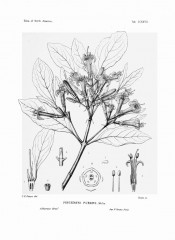Pinckneya pubens Michx.
A small tree with pubescent branchlets, ovate-lanceolate leaves, to 20cm long, and open clusters of white, pink-striped flowers in early summer. To 10m. One of the rarest trees of eastern North America. [Sargent - Silva of North America vol.5, p.109/1983].
Horticultural & Botanical History
‘The Georgia bark is a low tree, dividing itself into numerous branches, and rarely exceeding the height of 25 feet, and a diameter of five or six inches at the base. Its leaves are opposite, four or five inches long, of a light green color, and downy beneath, as are also the shoots to which they are attached. The flowers which are white with longitudinal, rose-colored stripes, are pretty large, and are collected in beautiful panicles at the extremity of the branches. Each flower is accompanied by a floral leaf, bordered with rose color near the upper edge. The capsules are round, compressed in the middle, and stored with a great number of small winged seeds. The wood of this tree is soft, and unfit for use in the arts ; but its inner bark is extremely bitter, and appears to partake of the febrifuge virtues of the Cinchona, for the inhabitants of the southern parts of Georgia employ it successfully in the intermitting fevers, which, during the latter part of summer and the autumn, prevail in the Southern States. A handful of the bark is boiled in a quart of water till the liquid is reduced one half and the infusion is administered to the patient. From the properties of the bark the Pinckneya has taken the name of Georgia Bark. This tree so nearly resembles that which produces the Peruvian vegetable, that some botanists have included them in the same genus.’ [Browne p.228].
History at Camden Park
Marked with a ‘c’, denoting grown at Camden, in an 1836 edition of Loddiges’ catalogue held at Camden Park [CPA]. Although almost certainly grown around this time it did not appear in any of the catalogues and was probably short-lived in the gardens.
Notes
Published Feb 08, 2010 - 03:46 PM | Last updated Feb 08, 2010 - 03:52 PM
| Family | Rubiaceae |
|---|---|
| Category | |
| Region of origin | South eastern North America |
| Synonyms | |
| Common Name | Georgia bark, Feverbark |
| Name in the Camden Park Record |
Pinkneya pubens |
| Confidence level | high |


